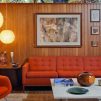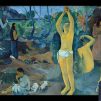
David Hockney is one of the most influential and daring British artists of the twentieth century and a key figure in the pop art movement, one of the first to openly speak about homosexuality. During his sixty-year career, Hockney has tried himself in a variety of genres and directions. The legendary artist, who has taken a decisive step into the age of technology, continues to seek new ways of expression today, remaining the same rebel, faithful to his love for bright colors and bold compositions.
The Youth
 David Hockney was born in 1937 in Bradford, a small industrial town in the north of England. His father, Kenneth, was an extremely eccentric person, although he worked all his life as an ordinary clerk. He wore two pairs of wristwatches in case one broke and never left the house without a hat, tie, and cane. Kenneth was a member of the organization for nuclear disarmament and a communist with a rather romantic and naive view of the Soviet Union. In the mornings, David’s father sent letters with his ideas about war and peace to political leaders: Stalin, Eisenhower, and Mao, and in the evenings, he took courses at the local art school.
David Hockney was born in 1937 in Bradford, a small industrial town in the north of England. His father, Kenneth, was an extremely eccentric person, although he worked all his life as an ordinary clerk. He wore two pairs of wristwatches in case one broke and never left the house without a hat, tie, and cane. Kenneth was a member of the organization for nuclear disarmament and a communist with a rather romantic and naive view of the Soviet Union. In the mornings, David’s father sent letters with his ideas about war and peace to political leaders: Stalin, Eisenhower, and Mao, and in the evenings, he took courses at the local art school.
It was his father who played a decisive role in the formation of Hockney as an artist and personality: he encouraged his son’s passion for art in every possible way and taught David not to be afraid to stand out from the crowd and not pay attention to what others say.
Laura, David’s mother, was a devout Methodist and vegan. She tried to raise her son on religious principles but did not really succeed in this. Hockney had a very warm relationship with his mother: he came to Bradford every Christmas until her death at the age of 99. Portraits of Laura Hockney are one of the most frequent themes in the artist’s work.
When David was 11 years old, he decided to devote his life to art. During his school years, Hockney was a “rather serious but cocky” young man. He was smart, but his academic success became an obstacle to his career as an artist: at Bradford College, gifted students were forbidden from choosing creative disciplines. Therefore, David deliberately failed the exams in order to continue to study painting.
The Career
A pacifist, Hockney refused to do military service “for reasons of conscience” and instead worked for two years in a hospital. At the same time, David discovered Sergei Diaghilev, a legendary theatrical and artistic figure who openly declared his homosexuality and was accepted by society. His honesty about his sexuality gave Hockney the courage to reveal his own.

At 22, Hockney moved to London and entered the Royal College of Art. He studied brilliantly, and his works won prizes and ended up in private collections. David experimented with different styles and directions, especially with abstract expressionism.
The young artist was greatly influenced by the exhibition of Pablo Picasso at the Tate Gallery, which he visited eight times. The 1961 work, Two Boys Fighting, was the first reflection of the theme of homosexuality in his art. References to contemporary visual culture, graffiti-like scribbles, and flashy colors characteristic of Hockney during that period caused disapproval of teachers but were received with enthusiasm by critics and became a significant contribution to the development of British pop art in the 60s.
In the last year of his studies, Hockney basically refused to write his thesis, arguing that the artist should be judged solely on the basis of his artistic success. As a protest, David drew a sketch entitled “Thesis”. A big scandal erupted, but in the end, Hockney still received his diploma. After graduating from college, Hockney traveled around Europe, visited Rome, Florence, and Berlin. Upon his return to London, the artist briefly taught at the Maidstone School of Art and moved to a new studio in the Notting Hill area. Gradually Hockney delved into the theme of romantic intimacy and began to paint couples in home interiors, as well as shower scenes.
The USA
In 1961, with the money raised from exhibitions, Hockney went to New York for the first time. The United States amazed the impressionable youth. The commercial success of his works prompted David to think about the possibility of moving to America, and at the end of 1963, the artist left conservative England for several decades.
Almost immediately, Hockney struck up a friendship with Andy Warhol and Henry Geldzahler, curator of the Metropolitan Museum of Art. Despite the prospects that the huge metropolis and the world center of contemporary art had in store for the young artist, David did not stay in New York.
Hockney fell in love with the image of sunny California as a child when his father took him to watch Hollywood films. Having never visited the west coast of America before, Hockney moved to Los Angeles, where he found real freedom. Hockney’s visual vocabulary of art styles was constantly changing: it was a combination of academic drawing, figurative painting, and abstraction.
At the same time, the artist first began experimenting with photography, using photos as drafts for future paintings. Hockney tried acrylics and began painting his first paintings of swimming pools and stylistically bold Southern California landscapes.
The pools caught Hockney’s attention on his first flight to Los Angeles. The artist was interested in how they reflected light, diluting the monotonous range of greenish-gray urban buildings with a bright aquamarine color. For David, they became a symbol of acquired freedom and an ideal motive for reflecting a different life.
The Return
 The decisive event that prompted David to return to his homeland was the death of his beloved dachshund. In 2005, at the age of 68, David crossed the ocean again and settled in his late mother’s villa in Bridlington, which became his studio for the next eight years.
The decisive event that prompted David to return to his homeland was the death of his beloved dachshund. In 2005, at the age of 68, David crossed the ocean again and settled in his late mother’s villa in Bridlington, which became his studio for the next eight years.
The years spent in America influenced his perception of his homeland and made him contemplate England with a different view. In the works of this period, restrained British nature appears in vivid color, reminiscent of the paintings of Van Gogh. Hockney himself did not deny the influence of the great Dutchman, who is a source of inspiration for the artist.
Hockney transformed manicured dull fields and forests of East Yorkshire into vibrant, sun-drenched, contrasting spaces filled with vibrant greens, pinks, oranges, and purples. David wanted the viewer to be able to “enter the landscape, feel themselves inside” the picture. Therefore, the size of some works reaches more than three meters in height and ten in length, and they are composed of dozens of canvases.
The Present
After eight years in Yorkshire, the 76-year-old artist returned to California and immediately took on another large-scale project – a series of portraits of friends, colleagues, neighbors, and acquaintances. This project can be viewed as a kind of retrospective of the artist’s own life: an album of the closest people who walked alongside on his life path.

In 2017, David Hockney celebrated his 80th birthday with a major exhibition in collaboration with the Metropolitan Museum of Art, the Pompidou Center, and the Tate Gallery. It was not without experimentation: Hockney painted a series of hexagonal paintings with the bottom corners of the canvases cut off. Thus, the artist wanted to achieve a feeling of expanding space and enhance the effect of perspective.
Today, after losing his hearing and surviving a stroke, David Hockney remains the same restless and enthusiastic experimenter as at the beginning of his career. He can still stand at the canvas for seven hours, declaring that “artists never retire.”





